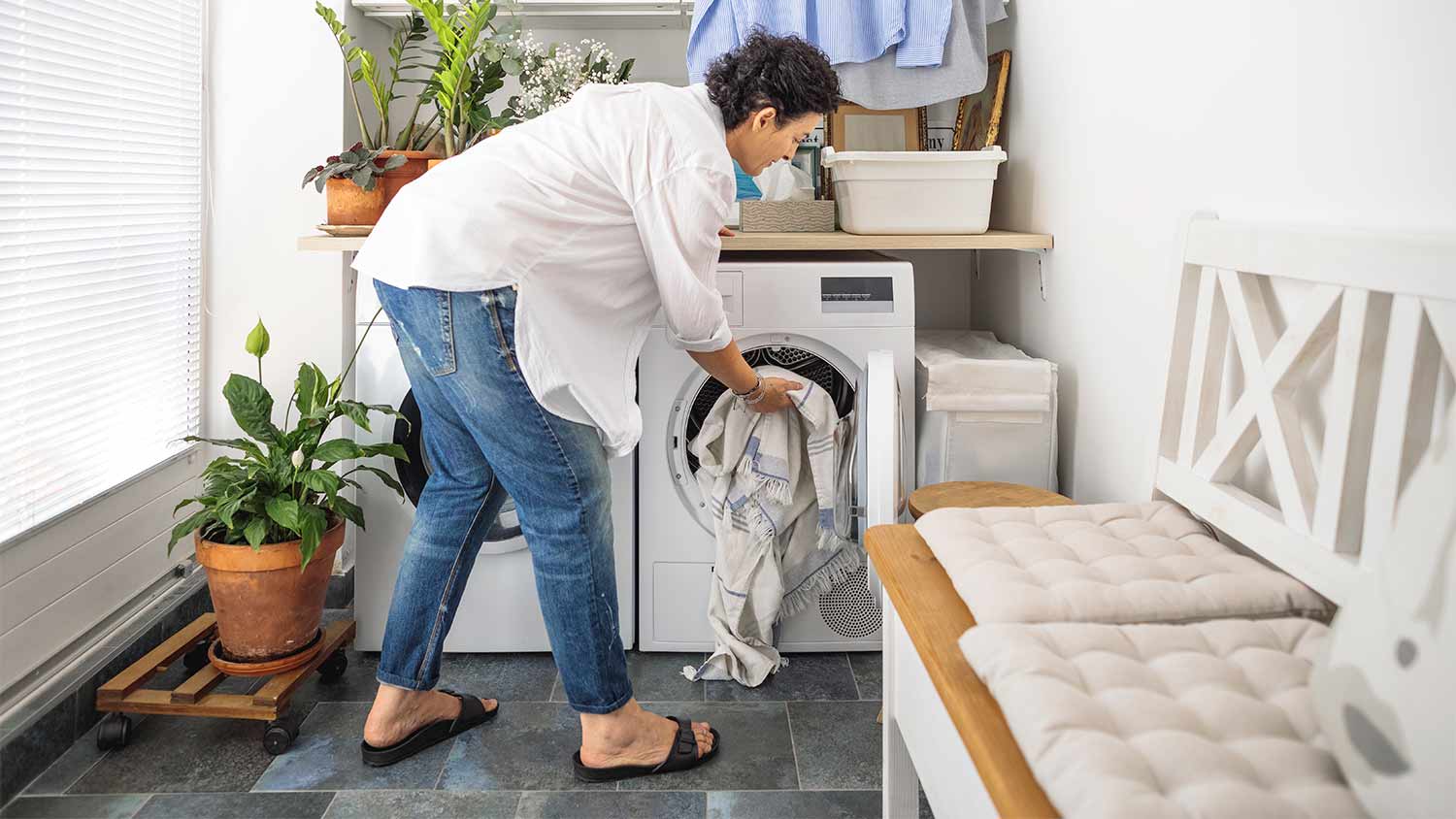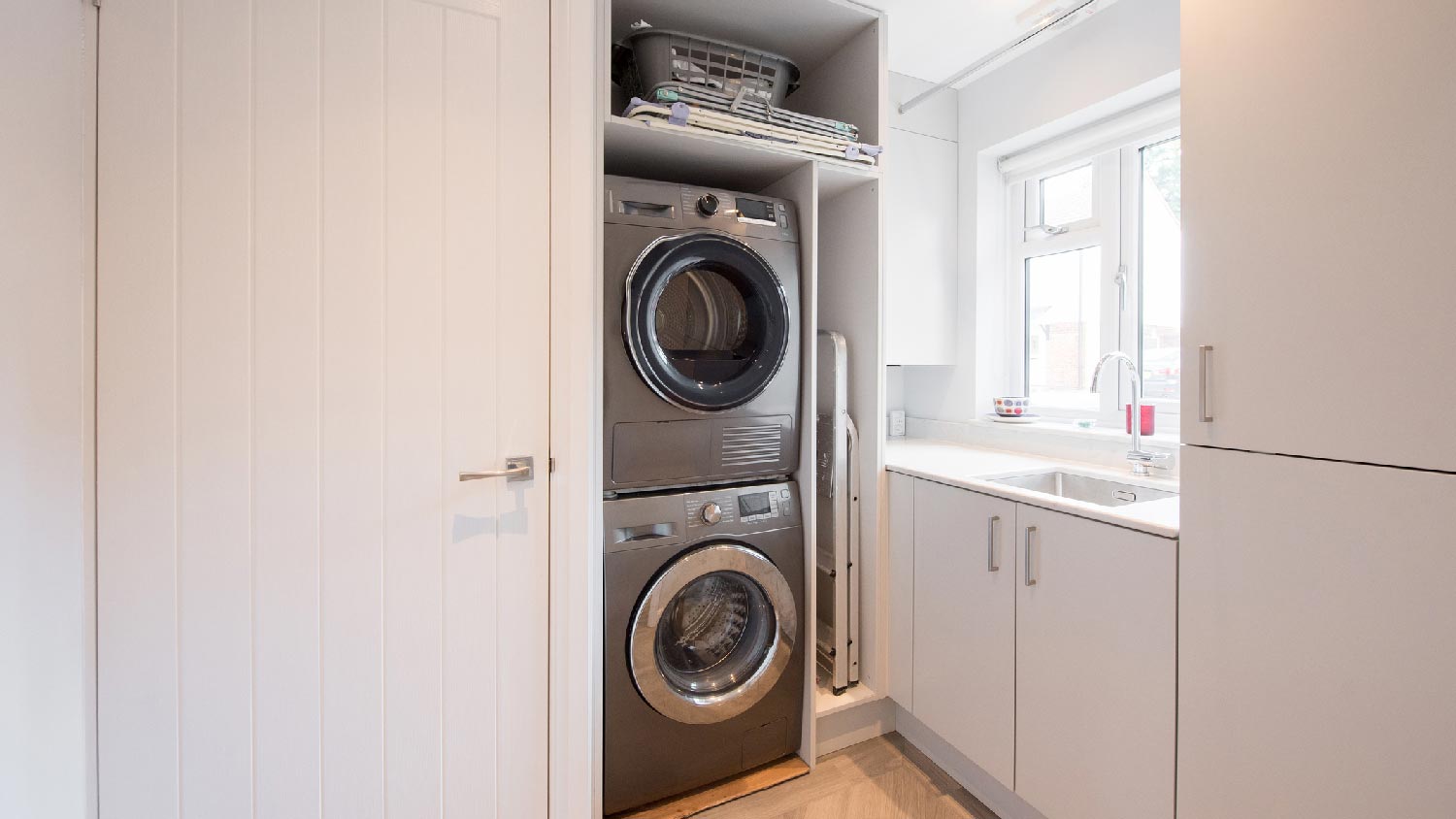How to Install a Range Hood Yourself and Keep Grease and Fumes Out
Cleaner kitchen air is just a few hours away with range hood installation


- Pencil
- Tape measure
- Drill
- Drill bit set
- Phillips-head screwdriver
- Range hood with hardware and template
- Metal duct sections
- Duct cap for wall or roof
- Foil tape
- Electrical cable
The aroma of a home-cooked meal is a treat for the senses—for a while. That’s why every kitchen needs a range hood to get rid of leftover odor, smoke, and steam. If your kitchen doesn’t already have one, installing a range hood is an excellent project for advanced DIYers that makes home cooking even more enjoyable.
Prepping to Install a Range Hood
Obtaining a permit for a new kitchen hood installation is usually necessary. However, you might not need one if you’re simply replacing an existing hood. Before doing any work, check with your local permit office to see what the requirements are in your area.
Next is to choose the type of range hood and size that fits your space. There are many options, but the most important criteria to pay attention to is the size and shape that fits your stove dimensions, as well as ventilation type. Secondary factors you may want to consider include noise level, finishes, and any smart features (like timers, lighting, and WiFi).
Learning how to install range hoods can involve electrical wiring and maneuvering around plumbing. If you don’t have the experience or training to handle this project safely, leave this one to the pros. An improper installation can lead to costly repairs down the road.
Remove the Existing Range Hood
 Photo: wertinio / Adobe Stock
Photo: wertinio / Adobe StockIf you’re replacing an existing range hood, start by removing the old one. Turn off the power at the circuit breaker. Double-check that the power is off with an electrical tester. Open the electrical box underneath the hood and disconnect the wiring. Have a friend or family member provide support for the unit. Unscrew the mounting screws, and remove the hood.
Identify an Exterior Venting Location
For new installations—or if you’re replacing a range hood that doesn’t vent to the outside—you’ll want to find the most accessible location to vent the new one. There are vented and non-vented hood options available, but most homes have (and this how-to is covering) vented range hoods.
If your hood backs up to an exterior wall, the easiest venting route may be directly behind it, through the wall. If venting through an exterior wall isn’t the best option, you may need to call in a pro to help you find the shortest route. Sometimes this may be through the roof, in which case we recommend having an electrician take over this project.
Mark the Venting and Mounting Holes
 Photo: Kurgu128 / iStock / Getty Images Plus / Getty Images
Photo: Kurgu128 / iStock / Getty Images Plus / Getty ImagesTo ensure installation success, use the hood itself—or the mounting bracket if your hood has one—as a template for locating drill holes. Have your helper hold the hood in place. With a pencil, trace the size of the venting hole on either the wall or the bottom side of the cabinet. Also, mark the mounting screw locations and, if necessary, a hole for the electrical wiring to pass through.
Cut the Ventilation Holes
You may want to cover the stovetop or move it out of the way. This step will create a mess.
Use a jigsaw, drywall saw, or hole saw to create a hole to accommodate the ducting. Drill pilot holes smaller than the diameter of the mounting screws at each attachment point. If necessary, use a large drill or spade bit to make a hole for the electrical wiring.
If venting to the outside directly behind the hood, use a long drill bit to penetrate the exterior wall and siding from inside the house. Create the hole directly in the center of the venting hole or at each of the four corners if it’s rectangular. If you’re running your vent through the cabinet, create a hole in the bottom of the cabinet. Make additional holes from there to get the duct work to the outdoors.
Using the locator holes outside the exterior wall, cut out the shape and size of the venting hole with whichever saw or hole saw is appropriate for your siding. When making your venting hole, you may have discovered plumbing pipes or electrical wires. If so, you may need to move the obstructions or call a local plumber or electrician for help.
Install the Ductwork
 Photo: ronstik / Adobe Stock
Photo: ronstik / Adobe StockInstalling ducts is often more manageable if you start outside and work your way toward the hood. Some range hoods even come with a damper attached to the interior vent hole. For wall vent installation, simply insert a length of duct from the outside to the hood. Install any necessary elbows or bends, and use foil tape to connect one section to the next.
You’ll likely need several duct sections to span the distance for roof vents. At the outside end of the duct, install the wall or roof cap following the installation instructions for the type you have. Again, if your venting requires roof access, this is best left to a pro.
Install the Electrical Wire
Most range hoods have an incorporated power switch, so you can typically access electrical power from a nearby outlet. Turn off the power at the circuit breaker to the outlet. Double-check that the power is off with an electrical tester, and remove the existing outlet from the wall.
Fish wire from the range hood to the outlet. Connect the new wire to the existing outlet, and reinstall the receptacle. Call a local electrician for assistance if there’s no outlet nearby or you’re uncomfortable working with electrical circuits.
Install the Hood
 Photo: New Africa / Adobe Stock
Photo: New Africa / Adobe StockYou can complete this next step alone, but it’s easier to have a helper lend a hand. Use the mounting screws to install the mounting bracket if your hood has one. Then slide the hood onto the frame and ensure that the duct connects to the hood exhaust.
For hoods with keyhole mounting points with a larger open circle and thinner slot, partially screw in the mounting screws at the pilot holes. Support the hood while sliding it onto the mounting screws and ensuring that the duct connects to the hood’s exhaust and the electrical wire protrudes into the connection box. Tighten the mounting screws.
For all other installations, have your helper hold the hood in place with the duct and wire lined up while you insert and tighten the mounting screws.
Test the Hood and Install the Vent Covers
The final step is to install a non-metallic cable connector in the electrical box hole to protect the wire and install the electrical cover and air filters. Once done, turn on the range hood to test it. If it starts running, then you’re all set. If it’s not running or you hear banging while it’s turning on, you may want to consult a pro to help diagnose the issue.
DIY Range Hood Installation vs. Hiring a Pro
Because installing a range hood requires working with electrical wiring and plumbing, it is best left to a professional. Improper installation can lead to costly repairs, and working with electrical wiring is dangerous. Put your safety first and hire a range hood installer near you.
Professional range hood installation costs an average of $750, though there might be a higher charge if the venting route is not straightforward or other mechanical systems are in the way.
Questions to Ask the Electrician Installing Your Range Hood
When looking for an electrician to install your range hood, interview a few local experts to find one with the right experience for the project. Be sure to ask:
Are you bonded, licensed, and insured? Without the proper bonds, licenses, and insurance, you could be on the hook financially if anything goes wrong during installation.
Do you have references? Any pro you hire should come with at least three references to back their work.
What kind of projects are you most familiar with? Make sure the electrician you hire has experience installing range hoods and can speak to the potential challenges posed by the installation.
Will you be performing the work or hiring subcontractors? Unless the project is very large and complicated, the electrician you hire should be the person completing the work.
Do you offer a guarantee or warranty? Most reputable electricians will offer a one-year work warranty. You should also ask if any of the required parts for the project come with their own warranty.
A range hood is an exhaust fan for your kitchen, and several types and styles exist. They are meant to remove grease, moisture, and fumes from your stove. Although some models filter and recirculate the air, the most effective ones remove the air through a duct that’s vented to the outdoors.
Yes, you still need to install a range hood above an electric stove. While electric stoves produce less heat than gas stoves, they still produce grease and fumes, which is the primary reason to install a range hood.
Ductless range hoods and hoods that have an option for recirculating air don’t have to vent to the outside. These hoods take in air, filter it, and recirculate it back into the room. Their charcoal filters eliminate much of the odor and smoke in the kitchen, but venting to the outside is still the preferred method.





- Appliance Repair Companies
- Washing Machine Repair
- Dryer Repair
- Refrigerator Repair
- Dishwasher Repair
- Oven Repair
- Wood & Pellet Stove Repair
- Freezer Repair Services
- Wood Stove Services
- Gas Stove Repair
- Emergency Appliance Repair Companies
- Ice Maker Repair
- Gas Appliance Repair
- GE Appliance Repair
- GE Refrigerator Repair
- GE Dryer Repair
- GE Dishwasher Repair
- GE Washing Machine Repair
- Samsung Appliance Repair
- Samsung Refrigerator Repair
- Samsung Dryer Repair
- Samsung Washer Repair
- Samsung Dishwasher Repair
- Samsung Oven Repair
- Whirlpool Repair
- Whirlpool Refrigerator Repair
- Whirlpool Washer Repair
- Whirlpool Dryer Repair
- Whirlpool Oven Repair
- Maytag Appliance Repair
- Maytag Refrigerator Repair
- Maytag Washer Repair
- Maytag Dryer Repair
- Maytag Dishwasher Repair
- Kitchenaid Appliance Repair
- Kitchenaid Oven Repair
- Kitchenaid Refrigerator Repair
- Kenmore Appliance Repair
- Kenmore Dishwasher Repair
- Kenmore Washer Repair
- Kenmore Dryer Repair
- LG Refrigerator Repair
- Bosch Appliance Repair
- Kenmore Refrigerator Repair
- LG Appliance Repair Services
- GE Microwave Repair
- Electrolux Appliance Repair
- Electrolux Washer Repair
- Kitchenaid Dishwasher Repair Services
- Wood Stove Inspection
- Dishwasher Installation
- Trash Compactor Repair










